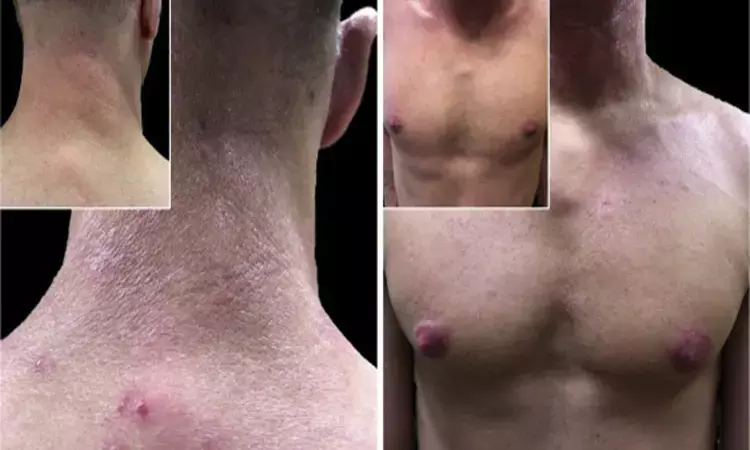- Home
- Medical news & Guidelines
- Anesthesiology
- Cardiology and CTVS
- Critical Care
- Dentistry
- Dermatology
- Diabetes and Endocrinology
- ENT
- Gastroenterology
- Medicine
- Nephrology
- Neurology
- Obstretics-Gynaecology
- Oncology
- Ophthalmology
- Orthopaedics
- Pediatrics-Neonatology
- Psychiatry
- Pulmonology
- Radiology
- Surgery
- Urology
- Laboratory Medicine
- Diet
- Nursing
- Paramedical
- Physiotherapy
- Health news
- Fact Check
- Bone Health Fact Check
- Brain Health Fact Check
- Cancer Related Fact Check
- Child Care Fact Check
- Dental and oral health fact check
- Diabetes and metabolic health fact check
- Diet and Nutrition Fact Check
- Eye and ENT Care Fact Check
- Fitness fact check
- Gut health fact check
- Heart health fact check
- Kidney health fact check
- Medical education fact check
- Men's health fact check
- Respiratory fact check
- Skin and hair care fact check
- Vaccine and Immunization fact check
- Women's health fact check
- AYUSH
- State News
- Andaman and Nicobar Islands
- Andhra Pradesh
- Arunachal Pradesh
- Assam
- Bihar
- Chandigarh
- Chattisgarh
- Dadra and Nagar Haveli
- Daman and Diu
- Delhi
- Goa
- Gujarat
- Haryana
- Himachal Pradesh
- Jammu & Kashmir
- Jharkhand
- Karnataka
- Kerala
- Ladakh
- Lakshadweep
- Madhya Pradesh
- Maharashtra
- Manipur
- Meghalaya
- Mizoram
- Nagaland
- Odisha
- Puducherry
- Punjab
- Rajasthan
- Sikkim
- Tamil Nadu
- Telangana
- Tripura
- Uttar Pradesh
- Uttrakhand
- West Bengal
- Medical Education
- Industry
Dupilumab effective in refractory bullous pemphigoid

Dupilumab effective in refractory bullous pemphigoid1
Bullous pemphigoid (BP) is a subepidermal immunobullous disorder characterised by autoantibodies against skin basement membrane zone (BMZ). Antibodies in BP are predominantly against BP180 and BP230, found within the hemidesmosomes of basal keratinocytes. Recently evidences of increased IL-4 and IL-13 cells in the blood and blister fluid of BP patients has given insight into role of IL-4 and IL-13 in the pathogenesis of BP.2 Dupilumab is a fully humanised monoclonal antibody against the IL-4 receptor α (IL-4Rα) subunit recently approved for atopic dermatitis. Recently a case of refractory bullous pemphigoid being successfully treated with dupilumab was reported in the Australasian Journal of Dermatology.
A 61-year-old woman presented with a 5-year history of generalised erythema, papules associated with severe itching initially diagnosed as atopic dermatitis. Patient later developed blisters. Biopsy from blisters showed a subepidermal blister with a lymphocytic and eosinophilic inflammatory infiltrate in papillary dermis. Direct immunofluorescence revealed linear deposits of C3 in the dermo-epidermal junction. The diagnosis of BP was made and the patient was started on methylprednisolone (0.5 mg/kg/day).
After 2 flares during the tapering of methylprednisolone, azathioprine 100mg daily was added to the regimen. The condition still relapsed and progressed to involve the face. Patient developed cushingoid phenotype with osteoporosis due to steroids. Due to patient's severe disease status and treatment side effects dupilumab was added to the treatment with an initial loading dose of 600 mg administered subcutaneously followed by a weekly 300 mg subcutaneous injection. With this novel treatment pruritus disappeared within one month, while no new blister developed.
At 5-month follow-up visit, the patient was in clinical remission, and azathioprine and topical steroids were then stopped. No flare was observed during tapering of methylprednisolone. Therapy for BP can be challenging, especially in recalcitrant cases. Systemic corticosteroids when given for long term have multiple side-effects.
In conclusion dupilumab can be an novel and effective steroid sparing agent for refractory or recalcitrant bullous pemphigoid which could curtail severe side effects of systemic corticosteroids.
Source-
1. Zhang Y, Zhang J, Chen J, Lin M, Gong T, Cheng B, Ji C. Dupilumab successfully treated refractory bullous pemphigoid with early clinical manifestations imitating atopic dermatitis: A case letter. Australas J Dermatol. 2021 Nov;62(4):525-527. doi: 10.1111/ajd.13692. Epub 2021 Aug 26. PMID: 34448201.
2. Teraki Y, Hotta T, Shiohara T. Skin-homing interleukin-4 and -13-producing cells contribute to bullous pemphigoid: remission of disease is associated with increased frequency of interleukin- 10-producing cells. J. Invest. Dermatol. 2001; 117: 1097–102.
MBBS
Dr Manoj Kumar Nayak has completed his M.B.B.S. from the prestigious institute Bangalore medical college and research institute, Bengaluru. He completed his M.D. Dermatology from AIIMS Rishikesh. He is actively involved in the field of dermatology with special interests in vitiligo, immunobullous disorders, psoriasis and procedural dermatology. His continued interest in academics and recent developments serves as an inspiration to work with medical dialogues.He can be contacted at editorial@medicaldialogues.in.
Dr Kamal Kant Kohli-MBBS, DTCD- a chest specialist with more than 30 years of practice and a flair for writing clinical articles, Dr Kamal Kant Kohli joined Medical Dialogues as a Chief Editor of Medical News. Besides writing articles, as an editor, he proofreads and verifies all the medical content published on Medical Dialogues including those coming from journals, studies,medical conferences,guidelines etc. Email: drkohli@medicaldialogues.in. Contact no. 011-43720751


